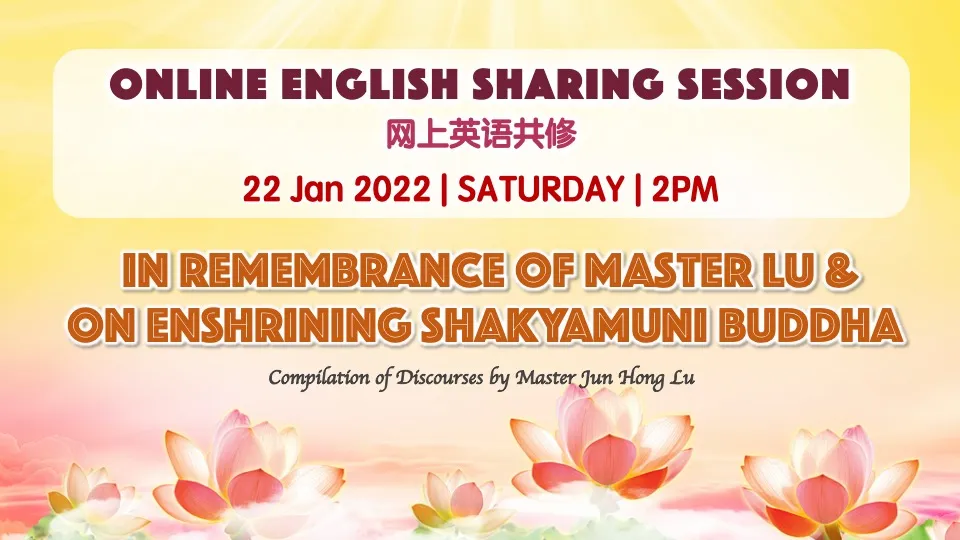Time : Saturday 2pm-4.00pm
Platform : ZOOM Cloud Meeting
Topic of Discussion : IN REMEMBRANCE OF MASTER LU & ON ENSHRINING SHAKYAMUNI BUDDHA
On 22 January 2022, Guan Yin Citta, Singapore held its first online English sharing session of the year.
The session kick-started with a brief look back of Master Lu’s life dedicated to propagating Buddhism and saving the wisdom life of sentient being.
The Quote of the Day:
“You are not in a kindergarten, where you need someone to watch over you all day long! I hope you will put in your best effort. Cherish the opportunity given to you by the Bodhisattva. Don’t muddle through life in this world, and keep falling down. You need to keep up, otherwise, you will be eliminated.”
To ensure Master Lu’s legacy contiues to live on, the participants were advised to:
1.Study Buddhism in Plain Terms and Master’s discourses diligently every day.
2. Make more efforts for the benefit of sentient beings, eradicate attachment and the notion of self.
3. Always be grateful for the grace and kindness bestowed upon you.
In the second part of the session, focus was put on one of Master Lu’s final advice to all Guan Yin Citta practitioners:
“From now on, all Guan Yin Citta practitioners are required to put the image of Shakyamuni Buddha on Guan Yin Citta Dharma Door’s Buddhist altar.” — 4 November 2021
The session shed light on:
1. A brief history of the Great Teacher, Shakyamuni Buddha.
2. The procedure on how to set up a Buddhist altar with Shakyamuni Buddha.
In an impactful testimony, a Buddhist friend shared her story of how enshrining Shakyamuni Buddha enhanced the energy of her Buddhist altar besides keeping the foreign spirits at bay.
Join us in our next session
Please contact Loh SX (96978356) / Woan Yi SX (82182248) for more information
⏰ Date and time:
Saturday 19 Feb 2022 (2pm – 4pm)
Please click here to download the Summary Slides shared during the Group Study:
![]() Summary Slides_In Remembrance of Master Lu & On Enshrining Shakyamuni Buddha
Summary Slides_In Remembrance of Master Lu & On Enshrining Shakyamuni Buddha
WHAT ARE WE LEARNING TODAY?
Part 1: In remembrance of Master Jun Hong Lu
Part 2: Procedure and protocols of enshrining Shakyamuni Buddha
< In Remembrance of Master Jun Hong Lu >
The founder of Guan Yin Citta Dharma Door and the renowned leader of the Australia Chinese community, Master Jun Hong Lu, who had accomplished His mission to perfection in the human realm, passed into parinibbana peacefully in Sydney, Australia, at the age of 62, at 4.00 a.m. on 10 November 2021.
Master Lu’s mission in propagating Buddhism can be traced as far back as 1997 before He founded Guan Yin Citta Dharma Door in 2006. Master Lu, who travelled to the breadth and width of the world, endured 20 years of hardships and tribulations spreading the Buddha-dharma. He had led over 10 million deluded sentient beings into the door of Buddhism to carry on the lifeline of Buddhism in this Age of Dharma Decline (续佛慧命). His boundless merits in promoting Mahayana Buddhism is exemplary to all in the three realms of existence.
Throughout His 20-year splendid journey in propagating Buddhism, He devoted all His life and experienced untold hardships to awaken sentient beings to believe the law of cause and effect and break the shackles of superstition. During His retreat for recuperation, Master Lu displayed great tenacity and unwavered spirit. He remained optimistic in His endeavours to spread the Buddha’s teachings.
He persisted in giving discourses on Words of Wisdom. He cared for the suffering humanity during the pandemic, instructing them to recite the Medicine Buddha Dharani to fend off the negative energy and the effects of collective karma.
Closely following the footsteps of the Buddha and promoting Guan Yin Bodhisattva’s spirit of compassion, Master Lu dedicated His life to the well-being of sentient beings.
< Shakyamuni Buddha’s Prophecy of Master Lu’s Attainment of Buddhahood >
Journey to Heaven – A Disciple from Malaysia
9 May 2020
Shakyamuni Buddha, “After your Master enters Nirvana at the end of His human life, He will once again radiate supreme light to illuminate the Saha World for the benefits of all sentient beings (发放大光明照耀娑婆国土利益众生). Thereafter, all Buddhas and Bodhisattvas of the Western Pure Land of Ultimate Bliss will come forth to receive your Master to His Lotus Seat in the Western Pure Land of Ultimate Bliss.
Soon after, right before Amitabha Buddha, Guan Yin Bodhisattva and Great Strength Bodhisattva (Da Shi Zhi Pusa), He will attain Buddhahood. He will pave the way and settle in Guan Yin Citta Pure Land to receive future heavenly beings from the Sound-hearers, Pratyeka Buddhas and Bodhisattvas’ realms. In this Pure Land, He will constantly deliver the dharma to all the Buddhist disciples.”
Shakyamuni Buddha continued, “Heavenly Child, please write an account of what I, Shakyamuni Buddha, have just said for your Master to verify. This is the absolute truth!”
A Disciple from Malaysia
9 May 2020
< The Life of Master Jun Hong Lu & His Noble Wish >
Master Lu has perfected the spirit of altruism by bearing the sufferings of sentient beings (以身命供养众生,代众生苦).
He has attained Buddhahood to perfection (究竟成佛). His mortal physical form may have passed into parinibbana, but His dharma body will live in eternity and His spirit of compassion will continue to shine universally.
It is now the responsibility of His disciples and Buddhist practitioners to carry on Master Lu’s mission of propagating Buddhism in order to realise Master Lu’s wish for Guan Yin Citta to thrive for generations to come.
Whenever you miss Master, READ THIS! Again and again!
< MASTER JUN HONG LU’S FINAL WORDS OF ADVICE >
Master Jun Hong Lu: Greetings to Buddhist friends around the world. It has been a long time since we last met.
Over the past year, I really miss all of you and you have always been on my mind. All of you are seeds of Guan Yin Citta Dharma Door (心灵法门的火种). No matter where I am, I will always be in the heart of each and every one of you. May the compassion of Guan Yin Bodhisattva forever brighten your hearts. I love all of you very much. It is my hope that you will persist in walking the path of the Buddha and never abandon your practice (坚持佛道,永不退转)!
Over a decade of hard work to spread the Buddha-dharma has exhausted me physically. As a result, I have also borne a very heavy burden of karma. That said, I have never relented in giving blessings to each and every one of you.
I truly hope you can study Buddhism in Plain Terms and my discourses diligently every day. Adhering to the teachings and observing the precepts are the basis for attaining Buddhahood. With all your heart, make more efforts for the benefit of sentient beings, eradicate attachment and the notion of self. Always be grateful for the grace and kindness bestowed upon you by the Buddha, your country, your teacher, your parents and sentient beings (心中常念佛恩、国土恩、师恩、父母恩、众生恩).
Along the path to Buddhahood, one must be sincere and truthful, full of courage and vigour, diligent, always think for the benefit of living beings, and dedicated to practising Buddhism. Shakyamuni Buddha and Guan Yin Bodhisattva will always bless those who uphold the Right Faith and Right Mindfulness (正信正念). The teachings of the Buddha need to be passed on from generation to generation (薪火相传).
I will endeavour to steer all of you to the shore of enlightenment. I truly hope that you will cherish this last Dharma Vessel in this Age of Dharma Decline. I treat the suffering of sentient beings as my own suffering. It is my wish that you attain Buddhahood in this lifetime to repay the kindness of the Buddha (一世修成报佛恩).
Master
5 November 2021
Key points:
- Study Buddhism in Plain Terms and Master’s discourses diligently every day.
- Make more efforts for the benefit of sentient beings, eradicate attachment and the notion of self.
- Always be grateful for the grace and kindness bestowed upon you.
Master Lu’s Advice (1): I truly hope you can study Buddhism in Plain Terms and my discourses diligently every day.
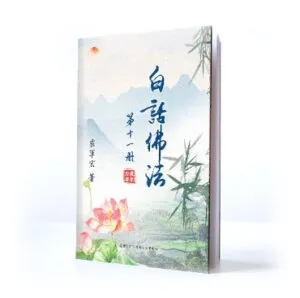
Wenda20130505A 55:50 (Master Jun Hong Lu’s call-in radio program)
STUDYING BUDDHISM IN PLAIN TERMS – THE KEYS TO ATTAINING ENLIGHTENMENT IN THE MORTAL WORLD
Caller: I have hit a roadblock in my spiritual cultivation. If I spend all my time reciting Little Houses everyday, will that deprive me of wisdom? How is it that other Buddhist practitioners can make such good progress in their spiritual cultivation?
Master Jun Hong Lu: It is simple, in order to gain wisdom, we have to perform recitations and study Buddhism In Plain Terms at the same time.
Master Jun Hong Lu: Don’t you think Buddhism In Plain Terms is the key that I have given for you to gain wisdom in this mortal world? Performing recitations will make you a better cultivated person. With this and the aid of the keys to solving worldly problems, don’t you think you will be able to open the door to wisdom?
Caller: I agree! The experience is extraordinary each time I read Buddhism in Plain Terms.
Master Jun Hong Lu: Absolutely!
Master Lu’s Advice (1) – Be Diligent!!
You need to be more enlightened, develop this positive habit of a Buddhist practitioner, that is, being self-aware where you don’t need others to push you to do your recitation. This is what it means by having self-awareness. You are not in a kindergarten, where you need someone to watch over you all day long!
I hope you will put in your best effort. Cherish the opportunity given to you by the Bodhisattva. Don’t muddle through life in this world, and keep falling down. You need to keep up, otherwise, you will be eliminated.
Master Lu’s Advice (2): With all your heart, make more efforts for the benefit of sentient beings, eradicate attachment and the notion of self.
Master Jun Hong Lu’s Buddhism In Plain Terms
Volume 1 Chapter 15 (An Excerpt)
EXPLAINING TO DISCIPLES ABOUT DELUSION OF VIEWS AND THOUGHTS
Master Jun Hong Lu: We must understand that the “self” that exists in this world is a false-self – not the true-self. If we cling to this “self”, we will become pathetic, and entrapped in the concept of “I”, and unable to be liberated from it. It is all because of the concept of “I” that people suffer. Do you know why it’s difficult for animals to be reborn as humans? It is because of the attachment to the notion of “self”.
Master Jun Hong Lu’s Buddhism In Plain Terms – Volume 9 Chapter 28 (An Excerpt)
THE ATTACHMENT TO THE NOTION OF SELF IS THE ROOT CAUSE OF ONE’S AFFLICTIONS
Master Jun Hong Lu: The Buddha once said, “True Dharma is about standing aloof from worldly affairs” (佛教本身就是无争的). At a certain point after setting foot on your Buddhism cultivation journey, you must not contend with others. Failing which, it only goes to show that you are not practising the Right Dharma.
As a matter of fact, a religion that propagates the principle of “zero dispute” stems from the notion of no-self. By letting go of the concept of self, conflict will cease to arise. If you are selfless, will you still contend with others? No. Mothers are selfless and hence, they will never wrangle with their children. After all, these are children they gave birth to.
Those who are altruistic will never contend with others because they are kind-hearted and are dedicated to the well-being of others instead of their own self-interests. Such a character is one that is devoid of self and will never jostle with others.
Master Jun Hong Lu’s Buddhism In Plain Terms
Volume 6 Chapter 45 (An Excerpt)
CONTEMPLATE THE DHARMA IS DEVOID OF SELF (观法无我)
Master Jun Hong Lu: Let me tell you about: “To Contemplate the dharma is devoid of Self” (“观法无我”). The word ‘dharma’ (法) in this context refers to the dharma realm (法界).
To “Contemplate the dharma is devoid of Self” (观法无我) means we should view “I do not exist in any of the phenomena in this dharma realm”. For example, do you see yourself being in this room now? Or when you see delicious food, do you think of yourself?
Spiritual cultivation is about learning to forget about the notion of ‘self’ in the midst of our many desires. The principle here is, it is through forgetting the “self” that one finds one’s true self (要忘却自我,才能找到真正的自我).
Let me quote you a simple example. A fight broke out among some children. The parents arrived. If the parents believed that their child had always been good and would never pick a fight with others, they would not even be looking out for their child among the group of squabbling kids.
On the same token, in this dharma realm, if we do not view ourselves as victims of this realm (法界的牺牲者), only then can we be liberated from this dharma realm (脱离法界).
Master Lu’s Advice (3): Always be grateful for the grace and kindness bestowed upon you by the Buddha, your country, your teacher, your parents and sentient beings.
Master Jun Hong Lu‘s
Words of Wisdom – Volume 2
Be grateful to the Bodhisattva.
When one’s heart is filled with gratitude, there is no room for hatred.
When we live our lives with feelings of gratitude, we will be blessed with happiness and joy.
Master Jun Hong Lu’s Public Talk, Melbourne, Australia
10 November 2018 (An Excerpt)
ADOPT A HEART OF GRATITUDE IN BOTH THE TRIALS AND BLESSINGS OF LIFE
Master Jun Hong Lu: As a Buddhist practitioner, in order to lead a life full of positivity, we must always be thankful in all circumstances and no matter what happens.
Give thanks to those who have helped us and to those who have caused us harm, we thank them for sharpening our resolve (磨炼了你的意志). Similarly, to those who have deceived us, we must be thankful to them for enriching our life experiences. To those who despise and are unkind to us, we must also be thankful as they are the ones who help us find self-respect (自尊), learn to bounce back from our setbacks and become stronger. Last but not least, be grateful to our destiny (命运) and to everyone, who has steepened our learning curve in making us more matured.
We need to understand that there is nothing in this world that is everlasting, or we can claim eternal possession of. Though so, we should cultivate an eternal heart of gratitude, a quality which can only be attained through our practice of Buddhism and effort in cultivating our mind (学佛修心).
Master Jun Hong Lu’s Public Talk, Melbourne, Australia
6 December 2019 (An Excerpt)
LEARN TO CHERISH
Master Jun Hong Lu: In our everyday life, many people feel that living off others is only natural and would take it for granted. As Buddhist practitioners, we should know that gratitude is an accomplishment in one’s cultivation (文化素养); it is a state-of-mind; even more so a responsibility for the society we live in. We must cherish all the kind acts of others toward us. To cherish is virtuous, a positive energy and a choice we make for a righteous mental disposition (正常心态).
Master Jun Hong Lu’s Motto:
“Calm is the heart with no desire”
无欲自然心如水
Master Jun Hong Lu’s Buddhism In Plain Terms – Episode 72 (An Excerpt)
“CALM IS THE HEART WITH NO DESIRE”
Master Jun Hong Lu: All of you are familiar with my motto in life: Calm is the heart with no desire. I hope all of you will break free from desires. Your heart should be calm like the water. When you have no greed, you will not give rise to hatred, and you will not do foolish things.
We need to see through the reality of things in life, understand the Buddhist doctrine and the truth within that teaches us that all desires are transient; they are hallucinations (迷幻) brought forth by one’s bewilderment.
When we are driven by desires, we go into a state of confusion (迷). Being ordinary mortals, we are seduced and we lose our soul. That is why I need to tell all of you that desires are detrimental.
The more we have, the more we want and the better we want them to be. With that, we step into the realm of greed and lose all control. This is the predicament (困境) you bring upon yourself because of your desires.
When you seize wisdom, you will have no more desires. You begin to understand that everything in the world is illusory (虚幻) – no matter how much happiness there is, it will all come to an end; and no matter how much pleasure it may be giving you, it will leave you one fine day. Then, you take a look at what is right in front of you and feel content, that’s when you will be most happy as you are no longer enticed by the things that used to be your objects of desire (不会受到欲念的诱惑).
人身难得,佛法难闻,明师难遇
It is extraordinary to be a human, rare to encounter the dharma & difficult to meet a good master.
< In Remembrance of My Revered Master! >
An Excerpt from 2OR Secretariat – 28 December 2021
IN REMEMBRANCE OF OUR REVERED MASTER: FOLLOW THE FOOTSTEPS OF YOUR MASTER AS YOU WALK THE PATH OF THE BUDDHA IN THE MORTAL WORLD; TRANSFORM PEOPLE FAR AND WIDE WITH ‘FAITH, VOW AND PRACTICE’
Buddhist practitioners viewed Master Lu’s final nirvana and perfect attainment of Buddhahood with mixed feelings.
We are full of joy because we have a Master who is now a Buddha, and He will compassionately protect our wisdom-life; we are sad because our Master is physically far from us now. Though so, the image and the voice of Master Lu will continue to live on in this world. Our Master will always be with us; He will always live in our hearts.
On the Eve of entering Nirvana, on numerous occasions, Master alluded, “It’s not easy to attain Buddhahood in the human realm. I’veendured an unspeakable amount of hardships and tribulations. To attain Buddhahood is a great vow, to attain Buddhahood is for the sake of sentient beings, not ourselves. All of you must tread this path with great resolution.”
He also said,
“To practise the Dharma, one needs to have three qualities:
Unyielding Character (骨气), Resolve (志气) and Courage (勇气) ”.
Guan Yin Citta Dharma Door is set to thrive under the compassionate protection of all Buddhas and Bodhisattvas. All disciples should give their devotion to the practice of Buddhism, honour the Master and revere his teachings and closely follow the footsteps of the Buddha. You must uphold the spirit of compassion of Guan Yin Bodhisattva and your revered Master; aim to pass on Guan Yin Citta Dharma Door to future generations and benefit more sentient beings with predestined affinity.
< Procedure and protocols of enshrining Shakyamuni Buddha >
- A brief history of Shakyamuni Buddha
- The procedure on how to set up a Buddhist altar with Shakyamuni Buddha
< A Brief History of Shakyamuni Buddha >
Master Jun Hong Lu’s Buddhism In Plain Terms (An Excerpt)
Special discourse on the Buddha’s Renunciation Day
Master Jun Hong Lu: Shakyamuni Buddha is known as “The Lone Compassionate One (能仁寂寞)”. He was, in fact, a Sage of the Shakya Clan. According to Buddhist scriptures, when the Buddha was 19 years old, he realised the sufferings arising from birth, old age, sickness and death. He abdicated the throne and renounced the world in search of the Truth to free humanity of suffering. Later, He attained “unsurpassed, complete, and perfect enlightenment”. Our Great Venerable Buddha entered Nirvana after 49 years of teaching.
< The Buddha’s Final Nirvana >
Master Jun Hong Lu’s Buddhism In Plain Terms (An Excerpt)
Special discourse on the Buddha’s Renunciation Day
Master Jun Hong Lu: “The Buddha was born due to a predestined great cause”. The birth of the Buddha was to come to the world for a great purpose that is to teach us so that we have an experiential understanding of the truth (开、示、悟、入). Through Him, we are able to dispel the bewilderment in our mind; to show our innate Buddha nature; to awaken our innate Buddha nature and thereafter tap into the Buddha’s knowledge and views, so as to eliminate ignorance.
The Buddha’s teaching is akin to a ship floating on the sea of suffering to lead sentient beings from the shore of life-and-death to the other shore of Nirvana.
Master Jun Hong Lu’s Talk, Guan Yin Hall, Sydney, Australia 31 May 2016
LIVE BY THE PRECEPTS
Master Jun Hong Lu: When the Lord Buddha was about to enter Nirvana, His disciples knelt before Him and asked, “Master, after you are gone, what are we supposed to do?”
The Lord Buddha answered, “The Precepts will be your teacher.”
As long as a person lives by the Precepts, he will never be strayed.
Cultivation of equanimity is essential to safeguarding our primitive heart, the one that is sincere in nature (本原的真心). You started off as a kind-hearted person, how did you become unkind afterwards? That is because you have stopped perceiving others with a heart of equanimity and became judgemental – “this person is bad, that person is good, this person is rich, that person has no social status.” All these will transform into ideology and the development of a mind that lacks equanimity. Little by little, it will be detrimental to the kind, compassionate heart of the Buddha in you.
< The Procedure on how to Set Up a Buddhist Altar with Shakyamuni Buddha >
Master Jun Hong Lu’s Discourse – 4 November 2021
IT IS REQUIRED TO PUT THE IMAGE OF SAKYAMUNI BUDDHA ON GUAN YIN CITTA DHARMA DOOR’S BUDDHIST ALTAR
The position of each Buddha and Bodhisattva’s image/statue
From left to right facing the altar: Tai Sui Bodhisattva, Nanjing Bodhisattva, Guan Yin Bodhisattva, Shakyamuni Buddha, Guan Ping Bodhisattva, Guan Di Bodhisattva, Zhou Cang Bodhisattva. The images of Guan Yin Bodhisattva and Shakyamuni Buddha are to be placed side by side in the middle. (The halo on the background landscape should be in the middle of the two images.)
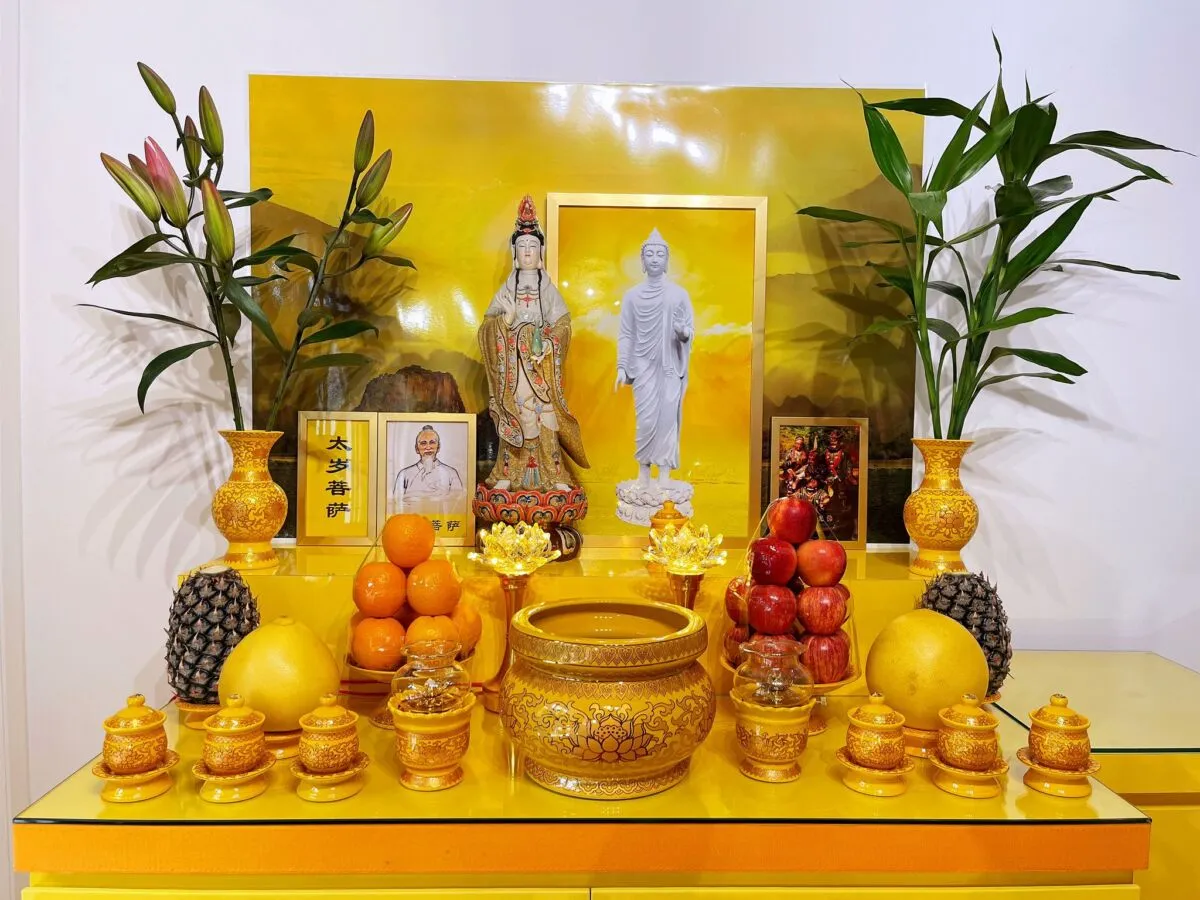
Master Jun Hong Lu’s Discourse – 4 November 2021
IT IS REQUIRED TO PUT THE IMAGE OF SAKYAMUNI BUDDHA ON GUAN YIN CITTA DHARMA DOOR’S BUDDHIST ALTAR
Procedure of inviting the image onto the altar and expressing gratitude
When offering incense, first express gratitude to Namo Shakyamuni Buddha, next express gratitude to Guan Yin Bodhisattva, followed by expressing gratitude to Nanjing Bodhisattva, Tai Sui Bodhisattva, Guan Di Bodhisattva, Zhou CangBodhisattva and Guan Ping Bodhisattva.
When setting up a new altar, follow the same order as above, inviting Namo Shakyamuni Buddha, followed by inviting the Greatly Merciful and Greatly Compassionate Guan Yin Bodhisattva.
How to invite the Buddha to enter the image?
Say the following prayer: “May the Greatly Merciful and Greatly Compassionate Guan Yin Bodhisattva invite Namo Shakyamuni Buddha to enter the sacred image offered by me, [your full name].” Then recite the holy name of “NamoShakyamuni Buddha” 108 times.
Number of bows after offering incense
Kneel down and bow three times to each Buddha’s and Bodhisattva’s image/statue.
Latest Greeting Script:
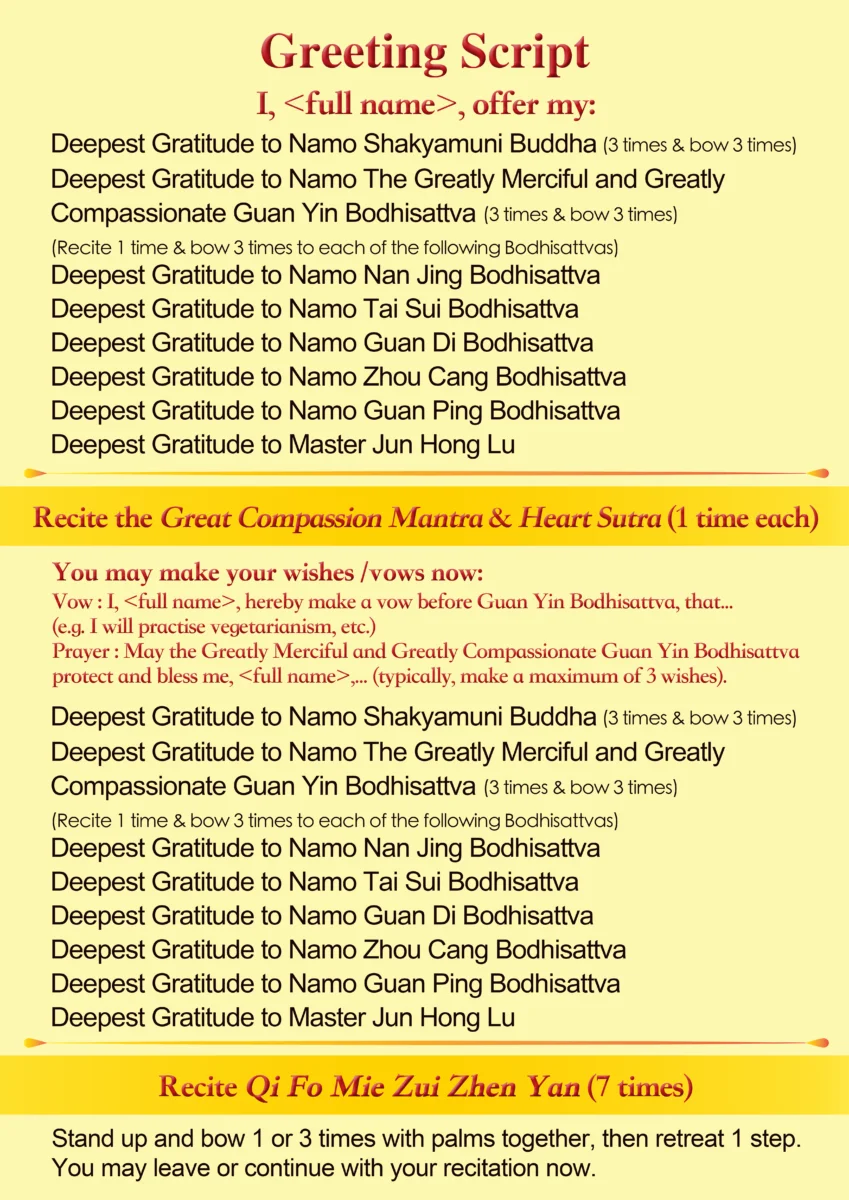
Offering Grand Incense
If a piece of sandalwood is to be offered as the grand incense, light the sandalwood in front of the Buddha’s incense burner; put out the flame and let the smoke permeate the incense burner, repeat this step three times.
Then repeat the same step for Guan Yin Bodhisattva’s incense burner. Lastly, insert the extinguished piece of sandalwood into the Buddha’s incense burner.
The sandalwood can be reused.

Offering Grand Incense
If the grand incense made of sandalwood powder is used (which will burn out by itself), light one stick and insert it into the Buddha’s incense burner. Then, light another stick and insert into Guan Yin Bodhisattva’s incense burner. Note that there is no need to light the stick three times as it will burn by itself.
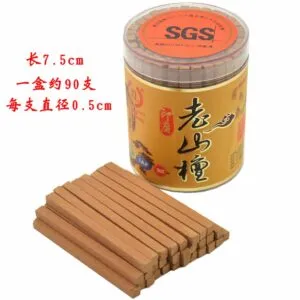
Number of oil lamps, cups and incense burners
If there are 6 existing incense burners and 6 oil lamps on the altar, it is required to add one more incense burner and oil lamp once the Buddha’s image is added since it is not recommended to use one incense burner for both Guan Yin Bodhisattva and Shakyamuni Buddha.
If there is only one big incense burner and two oil lamps on the altar, then it can remain unchanged.
It is required to add a new water cup.
Questions & Answers about Setting Up a Buddhist Altar with Shakyamuni Buddha
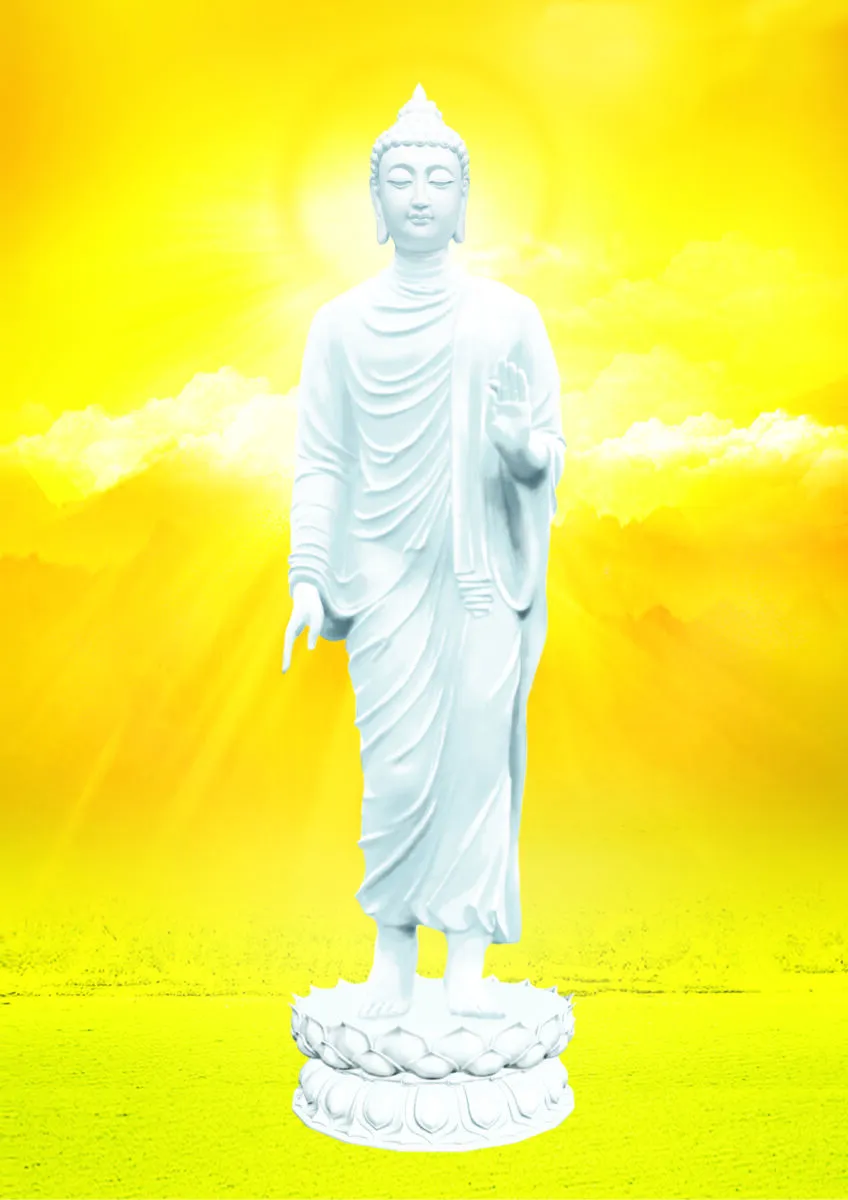
Q: Do we still pray to Guan Yin Bodhisattva when offering Little Houses and reciting the Buddhist scriptures?
A: The prayers remain unchanged.
Q: Having completed the recitation of Buddhist scriptures, can we express gratitude to NamoShakyamuni Buddha and Guan Yin Bodhisattva.
A: Yes, you may.
Q: At the site of performing life liberation, we face towards the sky and say the following prayer three times, “I express my sincere gratitude to the Greatly Merciful and Greatly Compassionate Guan Yin Bodhisattva,” before reciting sutras and praying to the Bodhisattva for blessing and protection. Is there any change to this procedure?
A: It remains unchanged.
Q: If I already have a seated statue of the Buddha, may I place it before the image of Guan Yin Bodhisattva or is it required to place it to the left of Guan Yin Bodhisattva?
A: According to the explanation above, the statue of the Buddha should be placed on the left side of Guan Yin Bodhisattva. That is, when facing the altar, the two images/statues are to be placed in the middle with Guan Yin Bodhisattva on the left and the Buddha on the right. If the condition does not permit, the Buddha image can be placed in front of the picture of Guan Yin Bodhisattva. However, please ensure that the size used will not cause your view of Guan Yin Bodhisattva to be significantly compromised, nor can it be too small relative to the images/statues of other Bodhisattvas.
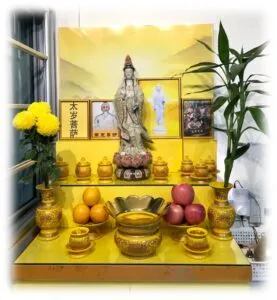
Q: If it’s not feasible for me to extend the Buddhist altar for the time being, can I leave it as it is now?
A: It is recommended that you add the image of Shakyamuni Buddha. The image can be slightly smaller but not smaller than the images of Nanjing Bodhisattva and the other Bodhisattvas.
Q: For some Buddhist friends, the image of Guan Yin Bodhisattva is quite big and needs to be placed behind the images of other Bodhisattvas due to space constraints on their Buddhist altars.
In this case, can the image of the Buddha be placed right in front of that of Guan Yin Bodhisattva?
A: Yes, but the Buddha’s image must not be smaller than other Bodhisattvas’.
Q: What should be the size of the Buddha’s image?
A: If possible and also a way to show our sincerity, the image of the Buddha should be as big as that of Guan Yin Bodhisattva. But if this is not feasible, it must not be smaller than those of Nanjing Bodhisattva and the other Bodhisattvas.
Q: Can the incense ashes from the incense burners of the other Bodhisattvas on the Buddhist altar be added into the incense burner of the Buddha?
A: Yes, you may.

Q: On auspicious days, should we offer 3 incense sticks to the Buddha and Guan Yin Bodhisattva each, while one incense stick to the other Bodhisattvas? Or should we offer 3 incense sticks to all Buddhas and Bodhisattvas?
A: Both are OK.
Q: People used to continue offering incense and put them in the incense burner of Guan Yin Bodhisattva when the earlier offered incense was about to burn out. With the added incense burner of the Buddha, what should we do now?
A: Now you need to offer incense to both the Buddha and Guan Yin Bodhisattva and put it in both incense burners. If you are in the Practice Centre, you can instruct Buddhist friends to continue offering incense in either incense burner. You need to ensure that there is incense in both incense burners. If you are at home, you need to offer incense in both incense burners.
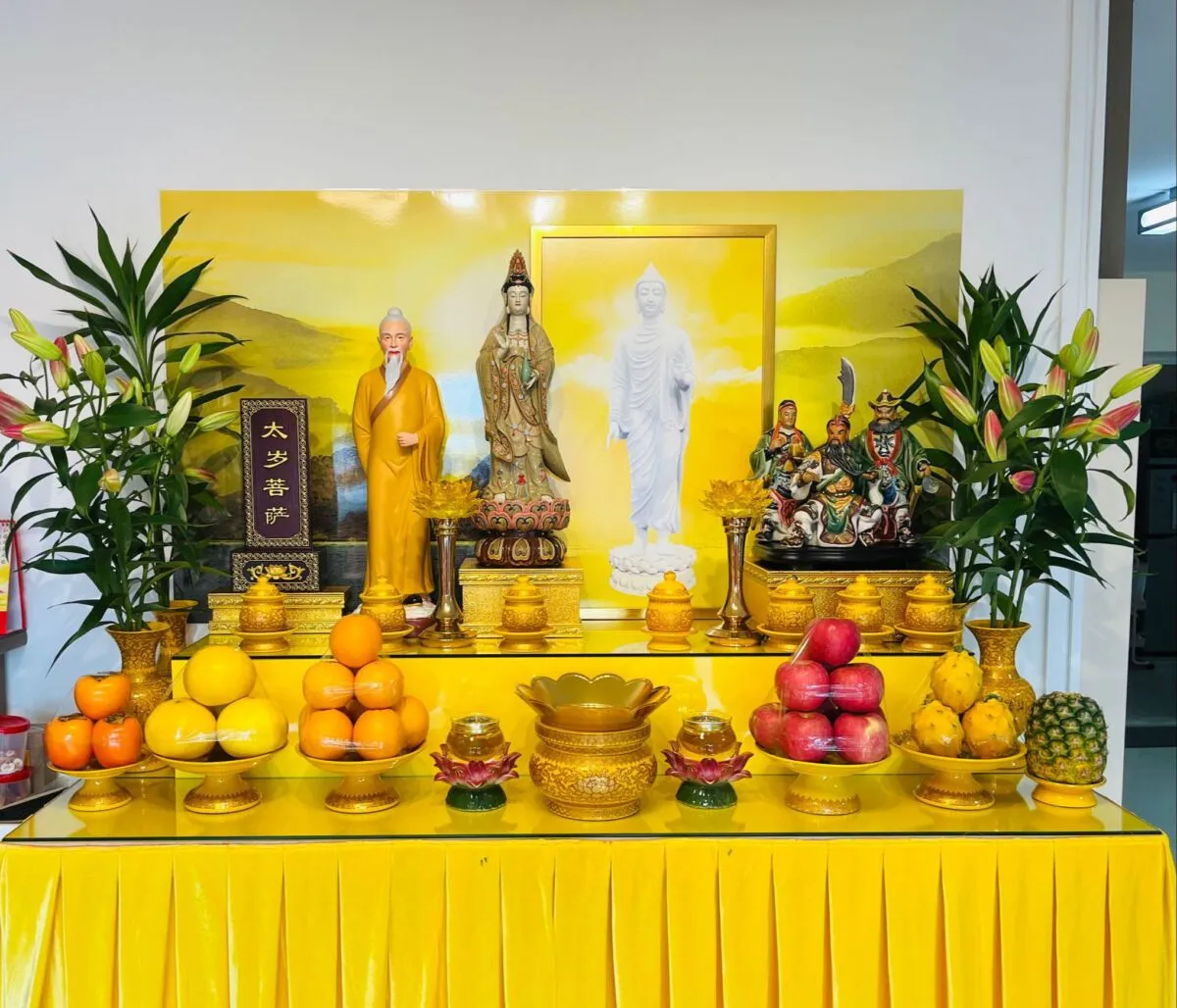
If you require assistance from our volunteers to set up a Buddhist altar following the procedures of Guan Yin Citta Dharma Door, please contact us by telephone (6222 2603) or email us at xlfmsgfotai@gmail.com.
< The Most Superior Form Of Offering >
Master Jun Hong Lu’s Discourse on Guan Yin Bodhisattva’s RenunciationDay
7 November 2017 (An Excerpt)
THE MOST SUPERIOR FORM OF OFFERING
Master Jun Hong Lu: As pious Buddhists, we often put our palms together in veneration of Guan Yin Bodhisattva and in admiration of the virtues. I have told you before and I hope you will listen attentively.
Before we perform our prostrations, we should gaze at Guan Yin Bodhisattva, as if we are keeping Bodhisattva in our heart, this is referred to as “admiring the virtue of the Buddha (仰慕佛德)”; this is when our conduct is based on the awareness of the Buddha.
To put it simply, when we perform prostrations today, our every conduct is that of the Bodhisattva, so is our line of thought and speech. When we perform prostration with this notion, this,
in itself, is the most superior form of offering.
Hence, the most superior form of offering is not about you offering some fruits on your Buddhist altar but rather, it is when your heart and the intention of the Buddha are one and the same.
Hence, in the past, it was said:
Our clasped palms symbolise a flower;
Our body symbolises the offering items;
Our kindness symbolises the incense;
And our admiration for the Buddha
symbolises the fragrant smoke.
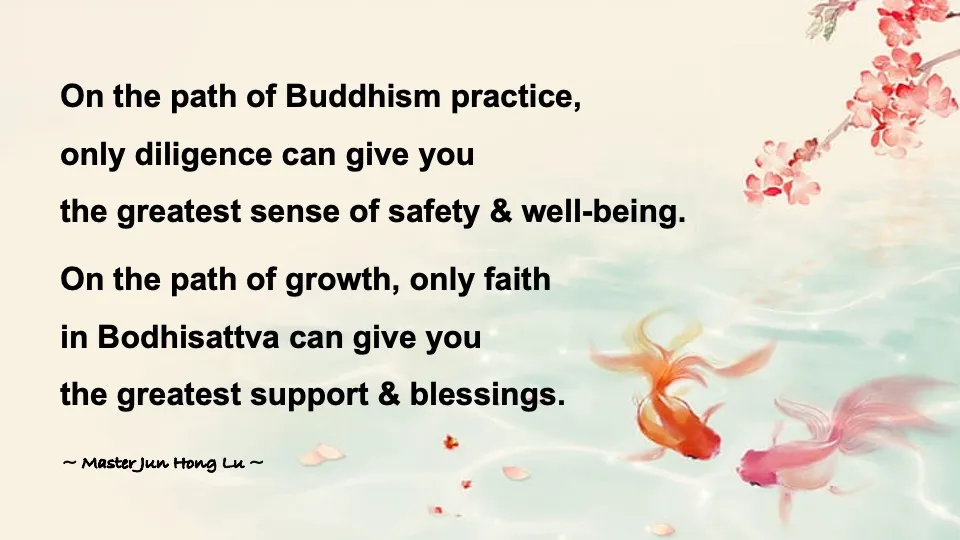
< Buddhism in Plain Terms < 白话佛法共修分享
